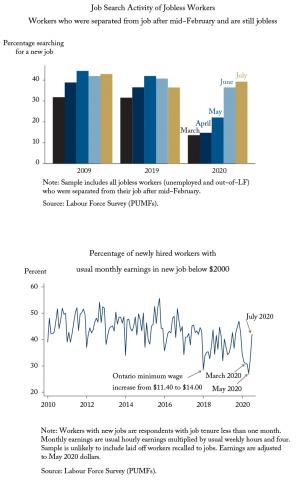From: Tammy Schirle and Mikal Skuterud
To: Bill Morneau, Minister of Finance
Date: August 12, 2020
Re: Job search, new jobs, and what it means for future policy
It is now widely recognized that the economic burden of COVID-19 shutdowns in March and April overwhelmingly fell on Canada’s lowest-wage workers.
Between February and April, aggregate hours worked by those earning less than $15 per hour dropped by 51 percent, while hours dropped by only 10 percent for those earning $35 per hour or more. Last week’s Labour Force Survey reveals that Canada’s lowest wage workers have also been the slowest to return to work as businesses re-open: by July their aggregate hours remained 30 percent below pre-shutdown levels, while the hours of high wage workers (earning $35 per hour or more) had actually increased to levels higher than we saw in February.
How concerned should we be that currently jobless workers have weak incentives to return to work?
With access to the CERB’s $2,000 per month – a benefit level that is near, and often exceeds, the earnings of Canada’s minimum-wage workers – the immediate gain of a return to work may be insufficient to motivate searching for and beginning a new job. Where those jobs pay more than $1,000 per month, they become ineligible for CERB entirely, potentially making them worse off. As labour economists, we are normally acutely concerned about the work incentive effects of worker income support programs.
However, despite our best efforts, we see no clear evidence that the CERB is currently disincentivizing jobless workers to search for and begin new jobs.
We examined the job search activity of workers who are recently jobless – having lost their jobs after mid-February – using the Labour Force Survey. Search activity was exceptionally low in March and April while many businesses were shuttered. But as businesses started to reopen in the spring, search activity picked up and has now reached normal levels (in comparison to search activity among jobless workers following the 2008-9 recession or at the same time last summer).
Moreover, and perhaps more surprisingly to some, we see no evidence that the earnings threshold for CERB eligibility is preventing low-earning workers from taking new jobs. When we looked at newly hired workers in Canada, the proportion earning below $2,000 in those new jobs fell in March, April and May when many businesses that employ low-wage workers were shuttered. But since then, we’ve seen their numbers rise, so that low-earners’ representation among new hires has returned to levels seen in the summers of 2018 and 2019.
As labour economists, we are always concerned about the need for income support programs to balance the need to support workers and their families during unemployment spells with the need to provide workers with incentives to search for and accept new jobs. Job searches were low in March to May, perhaps because of public health efforts to keep people at home, because of the CERB incentive some business groups pointed to, or because of the risks of COVID-19 in the workplace. What the recent LFS numbers suggest is that the work incentive effects of a short-term emergency benefit like CERB are now, if anything, small and perhaps even negligible. Because workers know the benefit is temporary, their concerns for ensuring employment in the longer term appear to be driving their behaviour. When job opportunities arise in the current uncertain climate, it is too risky to turn down those opportunities.
In the near future the federal government will present plans for moving CERB beneficiaries to Employment Insurance (and a parallel EI program for those not normally eligible for EI). In light of what we are seeing in the data, we suggest the following be kept in mind:
- In extending emergency support, meeting the income needs of families should be prioritized over work incentives.
- Reducing monthly benefits below $2,000 appears unnecessary to motivate workers.
- While reconsidering the strict $1,000 CERB eligibility threshold is sensible, it does not appear critical for the program design in terms of work incentives.
- The distinction between short-term and permanent program changes needs to be clear to everyone in the labour market. While a short-term emergency benefit may do little to reduce work incentives, more permanent changes to EI programs are likely to do more to discourage labour market attachment.
- Both the cause and the solution to the current economic crisis remain first and foremost the COVID-19 virus. Now is not the time to use income support policies to economically push workers back into potentially unsafe work settings that may contribute to a second wave of the virus.
Tammy Schirle is Professor of Economics at Wilfrid Laurier University, and Mikal Skuterud is Professor of Economics at the University of Waterloo.
To send a comment or leave feedback, click here.
The views expressed here are those of the authors. The C.D. Howe Institute does not take corporate positions on policy matters.






